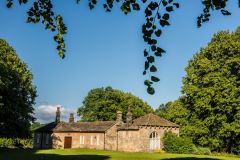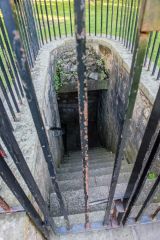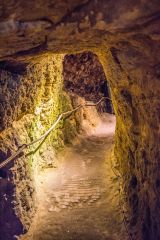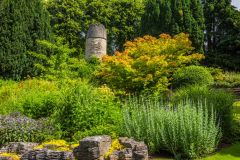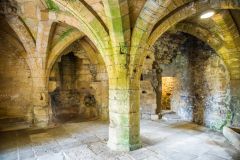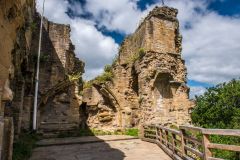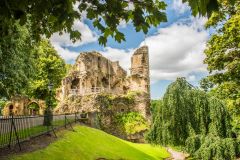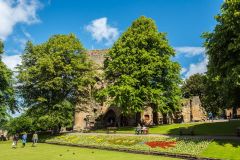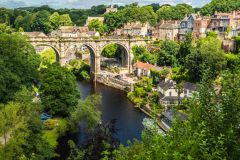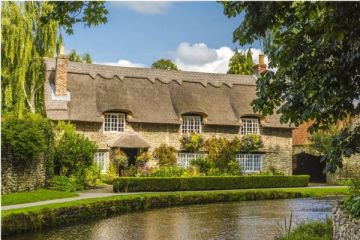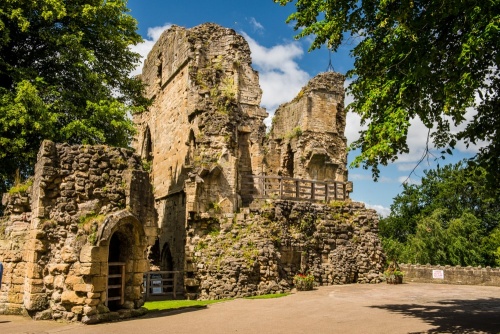
The impressive ruins of Knaresborough Castle stand in a picturesque location overlooking the River Nidd. Over the centuries the castle has been used as a royal residence and as a prison for the unfortunate Richard II. It was slighted by Parliament in the Civil War.
History
The origins of Knaresborough Castle go back to at least the year 1100 when it seems likely that a Norman baron erected a simple fortification on a high cliff above the River Nidd, looking over Knaresborough Forest.
There may have been a fortification here earlier. The town's name was recorded as 'Chednaresburg' in the Domesday Book of 1086. The suffix 'burg' comes from the Saxon word 'burh', meaning a fortified settlement. That fortification was probably little more than an earthwork ditch and bank, perhaps topped with a timber palisade.
The first written record of a castle comes from the Pipe Rolls (royal records) for the year 1129, when Eustace fitz John spent £11 on the 'king's works' at Knaresborough on behalf of Henry I. In 1170 Hugh de Morville, one of the four knights who murdered Thomas Becket in Canterbury Cathedral sought refuge in Knaresborough Castle in the aftermath of his deed. Three years later Morville joined Prince Henry's unsuccessful revolt against his father and was forced to surrender the castle to the Crown.
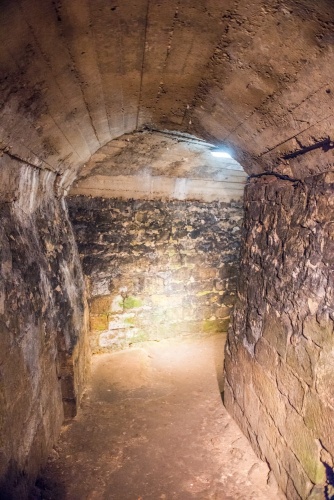
A Royal Residence
King John came here often and enjoyed hunting in Knaresborough Forest. In 1205 he strengthened the defences, adding the huge dry ditch that surrounds the site. Five years later in 1210, he gave the first Maundy Money from the castle. Maundy Money is a traditional gift to elderly people, dispensed on Maundy Thursday, the day before Good Friday.
Edward I and his son Edward II both strengthened the castle in the early 14th century. Edward I was responsible for the East Gate, with its twin towers. Edward II lavished money on the castle, and took a personal interest in the King's Tower, which explains the high quality of the masonry and carving detail.
In 1307 he gave it to his favourite, Piers Gaveston. Edward stayed here in 1312 when Gaveston was besieged in Scarborough Castle by a faction of nobles jealous of his influence over the king. Gaveston was forced to surrender and was beheaded.
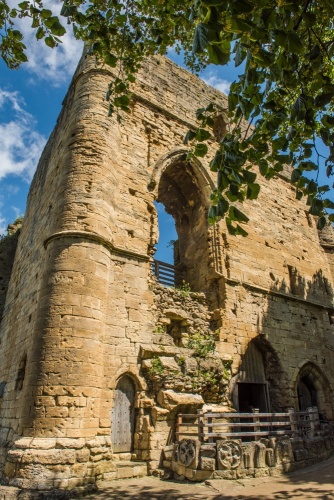
In 1317 the castle was captured by Thomas, Earl of Lancaster. The castle Constable was forced to besiege his own castle and batter the walls with a siege engine before the garrison surrendered. The castle withstood a raid by the Scots in 1318 but the town and priory were ransacked. On the plus side, Edward II granted the town its market charter, starting a weekly market that continues to this day.
Edward III granted the Honour and Castle of Knaresborough to his wife Queen Philippa as part of her marriage settlement. During her tenure the castle became a royal residence more than a military stronghold; the queen and her growing family spent summers here, surrounded by the royal court.
One of those family members who spent his childhood at Knaresborough Castle was John of Gaunt, Duke of Lancaster. In 1372 the Earl traded his estates in Richmond for Knaresborough, and from that date forward the castle has had close ties to the Duchy of Lancaster.
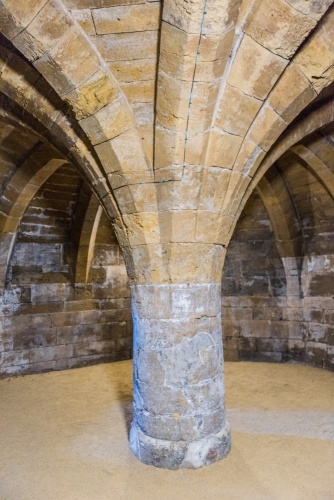
A Royal Prisoner
When John of Gaunt died in 1399 Richard II seized his estates, leaving Henry Bolingbroke, John's son, without his inheritance. Henry rebelled, gathered support from his Yorkshire estates, including Knaresborough, seized the throne, and captured Richard. The deposed king spent a night as a prisoner at Knaresborough Castle after his overthrow. He was probably kept in the King's Tower. Richard was transferred to Pontefract Castle where he was [probably] murdered.
From this point, the castle ceased to have a strong military function and served mainly as an administrative centre for the Duchy of Lancaster. The Courthouse was built - or rebuilt - in 1600 and cases from the Forest and Liberty of Knaresborough were heard here.
Civil War Destruction
The castle was held by Royalists during the Civil War. In 1644 Parliament besieged the castle. It took several months before Parliamentary cannons breached the wall, and the garrison surrendered. Parliament ordered the castle slighted (made unusable for military purposes). All buildings within the curtain wall were destroyed except the Courthouse. Parliament was in the process of tearing down the King's Tower when the townsfolk of Knaresborough petitioned for the right to preserve the tower as a prison.
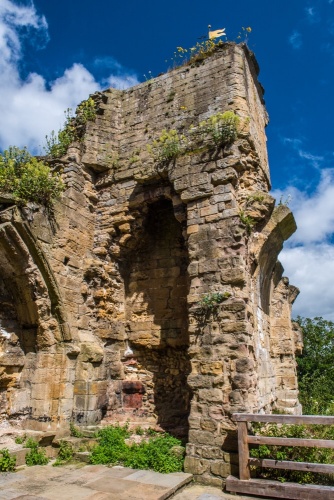
The Courthouse Museum
Over the next several centuries the castle grounds were transformed into a public park, with a bowling green and putting green. The Courthouse was transformed into the fascinating Courthouse Museum, telling the story of Knaresborough. Learn about life during the Civil War years and see the shirt worn by the Royalist leader Sir Henry Slingsby on the day of his execution.
The museum looks at the people who made Knaresborough what is today; people like 'Blind Jack' Metcalfe, who lost his sight at the age of six yet enjoyed a remarkable engineering career that enabled him to design and build over 180 miles of roads throughout Lancashire and Yorkshire.
Learn about Guy Fawke's connection to Knaresborough and see the original Tudor courtroom with its oak furnishings. Look for the trap door in the floor that allowed prisoners to climb up into the courtroom from their holding cells below. The Courthouse Museum also boats fine art from the Harrogate Borough Council's Collection.
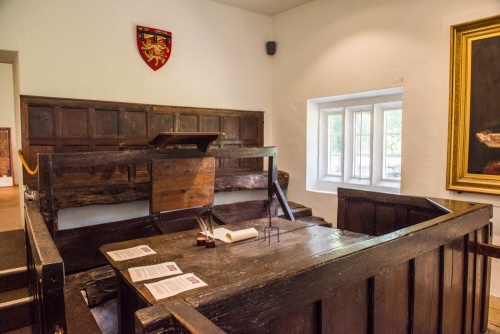
Highlights
- The Moat - a dry ditch dating to the early 13th century
- East Gate and Curtain Wall - Two massive semicircular towers flank one of the original two gateways
- The Sallyports - hidden within the outer ward, linked by underground tunnels from the inner ward
- The Courthouse - the 12th-century undercroft is the oldest part of the castle
- Courthouse Museum - retains its original Tudor furnishings
- King's Tower - a self-contained fortified residence, built from 1307-1312
- King's Chamber - Probably the room where Richard II was imprisoned in 1399. Beautifully-carved decoration.
- The Dungeon - a vaulted cellar with 12 rib vaults supported by a central column.
Underground Tunnels
Sometime in the late 13th of early 14th century two sally ports were built, reached by secret underground tunnels. These sally ports could be used to launch an unexpected attack on a besieging army, or simply to sneak in and out of the castle without being seen. The tunnels leading to the sally ports were large enough for a small band of armed men.
The tunnels were cut into the solid rock and roofed with rubble mortar. They slope steeply down to the level of the bottom of the dry moat to a hidden exit. You can take very enjoyable guided tours of the tunnels during the spring and summer.
The castle is owned by the Duchy of Lancaster but maintained by Harrogate Borough Council. The castle grounds are a public park, while the castle interior is open to the public for a small admission fee. I can highly recommend taking one of the special guided tours of the underground tunnels, leading to a hidden sally port.
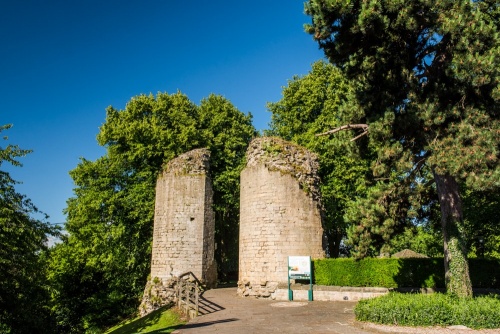
Getting There
The castle is extremely well signposted from major roads around Knaresborough. There is no dedicated parking on-site, but there are several pay and display car parks within easy walking distance. The castle is located on Castle Yard, off Kirkgate, a short stroll from the Market Place.
About Knaresborough Castle
Address: Castle Yard,
Knaresborough,
Yorkshire,
England, HG5 8AS
Attraction Type: Castle
Location: A very short walk from the Market Place off Kirkgate. Well-signposted from all surrounding roads. No dedicated parking.
Website: Knaresborough Castle
Email: museums@harrogate.gov.uk
Location
map
OS: SE348568
Photo Credit: David Ross and Britain Express
HERITAGE
 We've 'tagged' this attraction information to help you find related historic attractions and learn more about major time periods mentioned.
We've 'tagged' this attraction information to help you find related historic attractions and learn more about major time periods mentioned.
Find other attractions tagged with:
NEARBY HISTORIC ATTRACTIONS
Heritage Rated from 1- 5 (low to exceptional) on historic interest
Courthouse Museum - 0 miles (Museum) ![]()
Mother Shipton's Cave - 0.2 miles (Countryside) ![]()
Knaresborough, St John the Baptist Church - 0.3 miles (Historic Church) ![]()
Chapel of Our Lady of the Crag - 0.3 miles (Historic Church) ![]()
St Robert's Cave and Chapel - 0.9 miles (Historic Church) ![]()
Plumpton Rocks - 1.9 miles (Garden) ![]()
Goldsborough Hall Garden - 2.2 miles (Garden) ![]()
Tewit Well, Harrogate - 3 miles (Historic Building) ![]()
